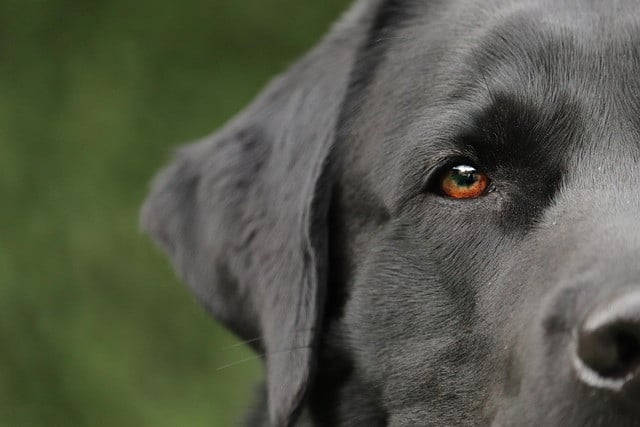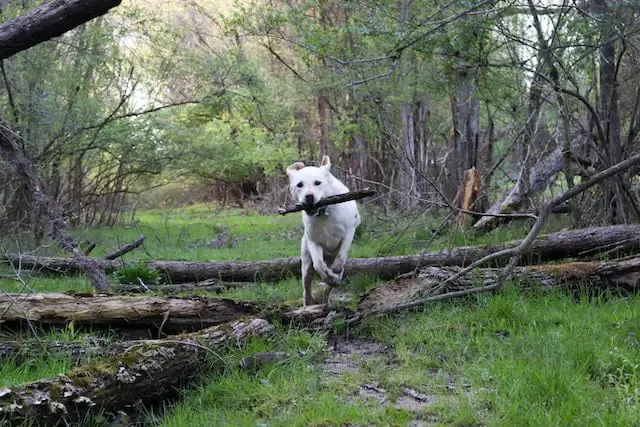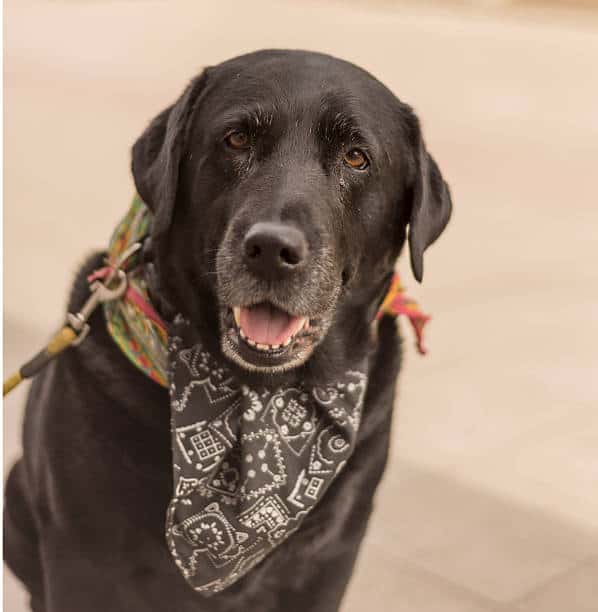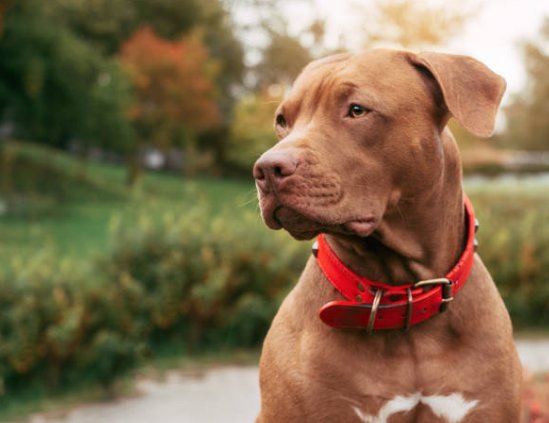Labradors – the official breed that has captured the hearts of millions of dog lovers worldwide. We’ll explore the two types of Labradors:- the English lab and the American labrador retriever. Both have a lifespan of about 10-12 years.
The two distinct types: are the American and English Labs. They share many similarities, such as friendly personalities and a love for the water. However, some key differences set them apart.
American Lab
People often refer to the American labrador retriever as the “field” or “working dog” Lab. This working type lab is known for its high energy levels. It makes them stand out among other popular breeds.

English Lab
The English Lab, on the other hand, is often referred to as the “show” or “conformation” Lab. Their calm and gentle nature is well-known. This characteristic makes them a sought-after option for both families and therapy work.

Types of Labs According to the Labrador Retriever Club
It’s fascinating to learn that the differences between the two types are limited to their appearance, temperament, and behavior. The Labrador Retriever Club is the only club for labrador retrievers.
The American Kennel Club has officially recognized it as the solely authorized organization serving as the national parent club for the labrador breed standards. According to their classification, there are two different types of labrador retrievers:
- American Labrador
- English Labrador
Both classes share the same breed standard, the main difference being the dog’s appearance.

Appearance Differences: english lab vs american lab
The American and English labrador retrievers have some subtle differences in their physical appearance:
Body Build
The ‘working type’ of lab is taller, leaner, and more agile. But, the English labrador retriever is shorter, stockier, and more muscular.
Coat
The ‘working type’ labrador retriever has a thinner, shorter coat. The English labrador retriever has a thicker, longer coat.
Color
Both types come in the same range of coat colors. There are yellow and black labrador retriever, and chocolate labrador retrievers. However, it’s worth noting that the English labrador retriever tends to have a yellow coat. The American labrador is more commonly a black labrador retriever.

Temperament Differences
There are notable differences in their temperament, which can affect how they interact with their owners and other pets.
Energy Level
American labrador retrievers are energetic dogs. They require more exercise and playtime than their English cousins. It is an ideal dog for active families or individuals who enjoy outdoor activities.
Trainability
Both types are intelligent and easy to train, but English labrador retrievers are generally more obedient and easier to handle than American labrador retrievers.
Attitude
English labs have a more laid-back, relaxed attitude, while American labs are more excitable and enthusiastic.
Behavioral Differences
The two types of labradors also exhibit different behavioral traits. Here are some of the key differences:
Prey Drive
American labs are more independent and have a stronger prey drive. Hence, they may tend to chase smaller animals or objects.
English labs are less likely to chase after prey. They are more content to relax with their owners.
Endurance Level
American labs have a higher threshold for pain and discomfort, making them more suitable for endurance and stamina activities.
English labs may tire more quickly. They have a different endurance level than their American counterparts.
Affectionate
English labs are more affectionate and enjoy spending time with their owners. They are known for their loyalty and devotion to their families. American labs, while also affectionate, may be more independent and less clingy with their owners.

Which Type of Labrador Makes the Best Pet?
Labrador retrievers are the most popular breed in the US. But, if you’re looking to get a lab, which types of labrador will suit you best?
American Type Labradors: Activities and Hunting
American-type labs are known for their high energy levels and athleticism. These labradors were bred as working dogs for hunting and retrieving games. They possess high stamina and love challenges.
If you’re an active person who enjoys outdoor activities like hiking, running, or swimming, then an American-type lab is perfect. Here are some of the characteristics of American labs that make them great for outdoor activities:
- High energy levels: The American breed is known for its high energy levels and stamina. They can run, swim with the help of webbed feet, and play tug of war for hours, making them perfect for active families.
- Athletic build: American labs have a leaner, more muscular physique than “show breeds.” It makes them faster and more agile. This quality is essential for activities such as agility training and flyball.
- Strong retrieving instinct: American labrador retriever has a strong retrieving instinct, which makes them excellent hunting dogs. They are also great at playing fetch and retrieving toys, making them perfect for families who love to play outdoors.
- Intelligent and trainable: An American lab is highly intelligent and trainable. They excel in obedience training. You can teach them a variety of commands and tricks.

English Labs for classic good looks
English-type breeds are known for their classic good looks and calm, friendly temperament. They are awesome as family pets. Initially bred as show dogs, they have a more relaxed and laid-back personality.
If you’re looking for a family pet that’s more of a couch potato than a workout buddy, then an English-type labrador retriever might be the right choice. Here are some of the characteristics of English labs that make them great pets:
- Calm and gentle temperament: Many labs of this breed have a calm and peaceful temperament that makes them great with children and seniors. They are affectionate, loyal, and love to be around people.
- Classic good looks: English labradors have a classic, traditional look that is highly sought after by many pet owners. They have a stockier build, shorter legs, and a broader head than American labradors, which gives them a more classic appearance.
- Excellent companion dogs: English labradors are wonderful companions and love being around people. They are great for families with children, as they are gentle and patient with kids.
- Lower energy levels: English Labradors have lower energy levels than American Labradors and are less active. Although they still need daily exercise, snuggling up on the couch with their owners and relaxing is an activity they enjoy.

What is a Drakeshead Labrador?
In the rolling hills of Lancashire, a passion for working with labs bloomed between two like-minded individuals, Sandra and John Halstead. Sandra and John Halstead collaborated to establish a breeding kennel club.
Their efforts paid off as the kennel club, Drakeshead, gained a reputation in the UK and other parts of the globe. But what are Drakeshead Labradors, and why are they so highly regarded? Let’s delve deeper.

The Origins of Drakeshead Labradors
In the early days of their partnership, Sandra and John shared a passion for showing, breeding, training, and competing with their dogs. They applied for an Affix from the Kennel Club to take their hobby to the next level.
Given John’s love of wildfowling, the couple combined the last part of their name with her quarry: the duck. Thus, the Drakeshead Affix was born, and a new chapter began in the history of labs and breed standards.
drakeshead labrador characteristics
Here are just a few of the characteristics that set them apart from other Labrador Retrievers:
Exceptional Hunting Ability
Drakeshead labs were specifically bred for the shooting field trials, so they excelled at hunting and retrieving games.
Their instincts, intelligence, and drive make them an ideal choice for hunters and gamekeepers. People often use them in field trial competitions.
Impressive Conformation
Drakeshead breeds also have exceptional conformation. They are well-built, with strong, muscular bodies, and have a striking appearance that sets them apart from other dogs.
Outstanding Temperament
One of the hallmarks of the Drakeshead breed is their exceptional temperament. They are friendly, outgoing dogs who love being around people. Highly trainable and eager to please, they bring joy to those who work with them.
Breeding Drakeshead Labradors
Breeding Drakeshead labs is a meticulous process. It involves careful selection of breeding pairs, health testing, and a focus on producing healthy, happy puppies that meet the breed standard.
The Halsteads only breed one litter a year, and there is always a waiting list for their puppies. If you’re interested in breeding your own Drakeshead, you have an option.
The Halsteads offer fresh, chilled, and frozen semen from seven stud dogs, allowing breeders worldwide and different kennel clubs to produce top-quality puppies.
What is the expected price range for Drakeshead puppies?
Prices for Drakeshead puppies range from $700 to well over $1,250, depending on the bloodlines. For those serious about working dogs that excel in field trials, a Drakeshead labrador retriever is well worth the investment.
Training Drakeshead Labradors
Training is essential as these dogs desire to work and please their owners. Here are some tips for training your Drakeshead labrador retriever:
Start early:
Begin training your puppy as soon as you bring them home. It will help establish good habits, and working lines and prevent bad behavior from developing.
Use positive reinforcement:
Drakeshead dogs respond well to positive reinforcement training methods. You can use methods such as praise, treats, and toys, when they are well-behaved. Avoid using punishment or negative reinforcement, as this can damage the bond between you and your dog.
Focus on obedience:
Obedience training is essential for all dogs, but more for working dogs like Drakeshead labs. Train your dog to obey basic commands like sit, stay, and come. As your dog progresses, move on to more advanced commands.
Provide mental stimulation:
Drakeshead breeds need mental stimulation to prevent boredom and destructive behavior. Provide plenty of toys, games, and activities that challenge their minds, such as puzzles or scent work.

Which Lab is Best for Me?
So how can you determine which Lab type is the most suitable for you? It’s time to pick the one. Here are some factors to consider regarding the living conditions:
Activity Level
How active are you? Do you enjoy going for long walks, hikes, or runs? Or do you prefer to relax on the couch?
A field labrador or American labrador retriever may best fit you if you are active. An English labrador retriever may be better if you prefer a more laid-back lifestyle.
Living Space
Where do you live? Do you have a large yard or live in an apartment?
If you have a large yard and live in a more rural area, an American Labrador Retriever may be a good fit for you. An English labrador retriever may be better if you live in an apartment or have a smaller living space.
Training Needs
How much time will you dedicate to training your new furry friend?
Labs are known for their trainability, but some subtypes may require more training. Field labs, for example, are bred specifically for hunting and retrieving. Therefore, they may need more exercise than other dogs.
Family Life
Do you have children or other dogs?
Labs are terrific for children and other pets. English Labradors, for example, are known for their laid-back personality and are great with children.
Grooming Needs
How much time can you dedicate to grooming your new furry friend?
This breed of dog has a thick, water-resistant coat that requires regular grooming.
Show labs, for example, have a thicker and hard coat than other subtypes and may require more grooming. An American labrador retriever may be better if you want a low-maintenance option.
Health Concerns
Like any breed, this dog can be prone to certain health issues. Researching is essential before choosing a Lab subtype. Some subtypes may be more prone to certain health issues than others. For example, English labradors may be more prone to obesity and hip dysplasia.
Cost
Show labradors, for example, may be more expensive due to their purebred status and show potential. On the other hand, the field ones may be less costly because they are bred as working dogs rather than for dog shows.
Making the Decision:
Once you have considered all these factors, choose a Lab that best fits your lifestyle and personality. Getting a Lab is a long-term commitment.
Labs have a life expectancy of 10-14 years on average. However, some can reach up to 19 years of age.
If still unsure which Lab subtype is correct, consider contacting a reputable breeder or Lab rescue organization. The breeders can help you find the perfect furry friend based on your needs and lifestyle
different types of labrador heads
Regarding Labradors, one of the most defining features of their appearance is their head. Labrador heads come in different shapes and sizes. We’ll also explore the concept of dual-purpose labs.
Blocky Head:
The Blocky Head labrador retriever is the most popular different types of Labrador head. It has a square-shaped muzzle, broad skull, and thick neck.
These Labradors have a distinctively masculine appearance, so they are often used as working dogs and for hunting.
Classic Head:
The Classic Head labrador retriever is more refined than the Blocky Head Labrador. It has a narrower skull and a longer, more tapered muzzle. People often use them as show dogs due to their elegant appearance.

Dual purpose Labs
As a dog lover, you may have encountered the term ‘dual-purpose labs.’ This phrase refers to Labrador Retrievers that excel in both hunting and show-ring. These versatile dogs are the perfect blend of beauty, brains, and brawn.
What Types of Working Dog Roles do Dual Purpose Labs Excel in?
Dual-purpose dogs can excel in a variety of operational roles, including:
Search and rescue:
The service dog has an excellent sense of smell. Trainers can train them to assist in search and rescue efforts.
Assistance dogs:
Dual-purpose breeds can be trained as assistance dogs for individuals with disabilities, providing support and assistance with daily tasks.
Law enforcement:
This dog breed has a strong sense of smell and can be trained to detect drugs, and sniff drugs or explosives.
How do I find a dual-purpose Lab?
Search for trustworthy breeders if you want to own a dual-purpose Lab. They have expertise in breeding and training dual-purpose labs.
6 Labrador Colors
Did you know that there are six labrador colors? Let’s delve deeper into each primary color to examine each in more detail.
1. Black Labrador
Perhaps the most well-known labrador color, a black labrador retriever is sleek and beautiful. A black lab coat is typically solid black, although some may have small white markings on their chest or toes.
2. Yellow Labrador
Another popular labrador color, yellow Labs, can range from a light cream color to a deep golden hue. They’re known for their sunny dispositions and friendly personalities.
3. Chocolate Labrador
Chocolate labrador retriever is a beautiful dog. A chocolate lab has rich, chocolate-colored coats ranging from light to dark. A chocolate labrador retriever is just as friendly as its black lab and yellow counterparts but with a unique look.
4. Red Fox Labrador
This color is less common than the others but no less stunning. The red fox breed has a reddish-gold coat that’s sure to turn heads.
5. Silver Labrador retriever
A silver lab is controversial among some breed enthusiasts. A silver labrador retriever has a beautiful, metallic coat that ranges from light silver to charcoal gray. Some argue that these dogs are not true Labradors, but many still love them.
6. White Labrador
White labs are not pure white but have a very light yellow or cream-colored coat. They’re rare and unique. However, they still have all the beautiful qualities that make them such great pets.

FAQs on different breeds of labrador retrievers
Which Labrador breed is best?
The best labrador retriever breed is relative. It depends on your lifestyle and preferences. Consider factors like activity level, coat type, and size.
Which Labrador is the calmest?
The calmest labrador retriever breed is the English labrador retriever. They tend to have a more relaxed demeanor than American Labradors.
Which is the most famous Labrador?
The most famous labrador retriever is likely the yellow Lab, often featured in movies and TV shows.
Which Labs are the biggest?
The largest labrador retriever breed is the English labrador retriever, which can weigh up to 100 pounds.
Who is the No 1 dog in Labrador Retriever?
The labrador Retriever is consistently ranked as the No. 1 dog breed in the United States. It is one of the most popular breeds in the world.
What is the difference between Labra and Labrador?
“Labra” is not a breed; it may refer to mixed dogs, including labrador retrievers. “Labrador” refers specifically to the breed.
Which Lab color is best?
The best labrador retriever color is subjective and depends on personal preference. Common colors include black, yellow, and chocolate lab.
Which is Better Boy or Girl Labrador?
The temperament of a labrador retriever depends on the individual dog, not its gender. Choose a dog based on personality, not gender.
Author Profile

- Lifetime dog Enthusiast
- Shradha is a seasoned writer at Labradorandyou.com, an authoritative resource for all things Labrador Retriever. Her experience as a pet owner and dog enthusiast drives her to create meticulously researched and fact-checked content, offering valuable insights on Labrador training, grooming, and health. Each article reflects Shradha's passion and dedication, enriched by personal experiences with her beloved Labradors, Tom, and Kurt. Whether exploring breed-specific training techniques or providing product reviews, Shradha ensures Labrador owners receive the most accurate, up-to-date, and trustworthy information, aimed at enhancing their companions' health and happiness
Also by the author
-
 Lab-TypesJune 30, 2025Мостбет Букмекер: Официальный Сайт Игровых Автоматов Mostbet Bookmaker
Lab-TypesJune 30, 2025Мостбет Букмекер: Официальный Сайт Игровых Автоматов Mostbet Bookmaker
-
 MonobrandJune 30, 2025Fontan Casino ️ One Hundred Pln Darmowy Zakład Bez Depozytu
MonobrandJune 30, 2025Fontan Casino ️ One Hundred Pln Darmowy Zakład Bez Depozytu
-
 Lab-TypesJune 30, 20251xbet Зеркало рабочее На Сегодня прохода На Сайт 1хбет Обновлено!
Lab-TypesJune 30, 20251xbet Зеркало рабочее На Сегодня прохода На Сайт 1хбет Обновлено!
-
 Lab-TypesJune 30, 2025Мостбет Mostbet Букмекерская Контора: Зеркало, Официальный Сайт, Бонус При Регистрации
Lab-TypesJune 30, 2025Мостбет Mostbet Букмекерская Контора: Зеркало, Официальный Сайт, Бонус При Регистрации